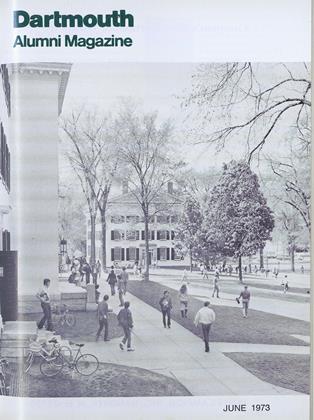Competent Egyptologists, though fully recognizing the importance of some 35,000 decorated blocks in the Akhenaten Temple Project, nevertheless gave up in despair because the mammoth jigsaw puzzle was beyond human comprehension in the translation of seemingly insoluble languages. But for the past six years Ray Winfield Smith '18 of Oak Hill, Dublin, N.H., with the help of electronic computers has largely solved the problem about hopelessly jumbled groups of the small sandstone blocks, identical in size, resting in storehouses and lying in the open air at Karnak. They are known to have come originally from one or more structures erected during the reign of Amenhotep IV (Akhenaten). When dismantled from their source structures, they had been re-used invisibly as foundations under the huge columns of the Hypostyle Hall as stuffing in the IInd and IXth pylons, and, no doubt, elsewhere. Recovered during the past 60 years or so, hopelessly jumbled, the sandstone blocks offered beautiful scenes clearly suggested by splendid sunken relief cutting and polychrome colors, but the proper juxtapositions had evidently been lost forever. Though the importance of this archaeological treasure was clearly evident, the task seemed too complicated to be practically mastered.
Finally the computer was brought into the Akhenaten Temple Project. The computer did indeed lack supernatural intelligence, firm opinions, and the capacity to perform any service except on explicit instructions of human minds based on facts intelligently presented. But it did enable scholars to discover: (1) how these blocks originally fitted together to embellish the walls of their source-structure(s); (2) the location, size, nature, and layout of each building; (3) the contributions of art, religion, and architecture of the period
Thus each of the 35,000 blocks was photographed, prints were examined by the Egyptologically trained staff, and all significant facts were fed into the computers of International Business Machines in Cairo. The thousands of pages of data, returned in dozens of "computer lists," enable scholars to visualize original wall positions without leafing through tens of thousands of photographs.
The data of the 35,000 blocks have been indelibly recorded on magnetic tape available to anyone needing it at any time in any desired form This information, and much more, is contained in an article by Ray Winfield Smith entitled "Computers en de Egyptologie," printed in the September 1972, Nummer 9, edition of SpiegelHistoriael: 150 Jaar Egyptologie, published in Bussum, near Amsterdam, Netherlands. Illustrated, the article is in Dutch, untranslated
Probate attorneys, trust officers, life underwriters, law school students, and candidates for bar examinations may profit by the revised edition of Wills, Trusts. Probate, Administrationand the Fiduciary in Smith's Review, Legal Gem Series, published by the West Publishing Company of St. Paul, Minn. The co-author is Wilton S. Sogg '56 of Ginsburg, Guren and Merritt of Cleveland, who is also Adjunct Professor of Law, Cleveland-Marshall College of Law, Cleveland State University. This review combines the revised and up-dated texts of two separate volumes in this series: Trusts and Wills and Administration. To alert readers to important areas of change and development the authors have made use of CAVEAT and NOTE. Chapter XIII, "Life Cycle of Estate Administration," entirely new, provides a chart and text for an overview of the administration of estates. Special attention has been given to the advent of the Uniform Probate Code and its likely effect on the development of law in the near future. A Table of Statutory References keys in text citations to the Uniform Probate Code, the Restatement of Trusts, Second and other statutory materials.
 View Full Issue
View Full Issue
More From This Issue
-
 Feature
FeatureHow the Dutch Handle It
June 1973 By Robert D. Haslach '68 -
 Feature
FeatureTHE FIRST COED YEAR
June 1973 By Bruce Kimball '73 and Andrew Newman '74 -
 Feature
FeatureRETIRING FACULTY
June 1973 -
 Feature
FeatureClass Officers Weekend
June 1973 -
 Feature
FeatureAvalanche Authority
June 1973 -
 Feature
FeatureEditors' Editor
June 1973 By MARY ROSS
J.H.
Books
-
 Books
BooksRemembering Fenway
July/August 2011 -
 Books
BooksNEIGHBORHOOD GROUPS AND URBAN RENEWAL.
JULY 1966 By FRANK SMALLWOOD '51 -
 Books
BooksThe Governments of Foreign Powers
October 1947 By Harold R. Bruce -
 Books
BooksTHE ILIAD OF HOMER
March 1952 By Philip Wheelright -
 Books
BooksFROM WHENCE COMETH MY HELP
March 1940 By Roy B. Chamberlin -
 Books
BooksTOLSTOY
JANUARY 1929 By Stearns Morse








